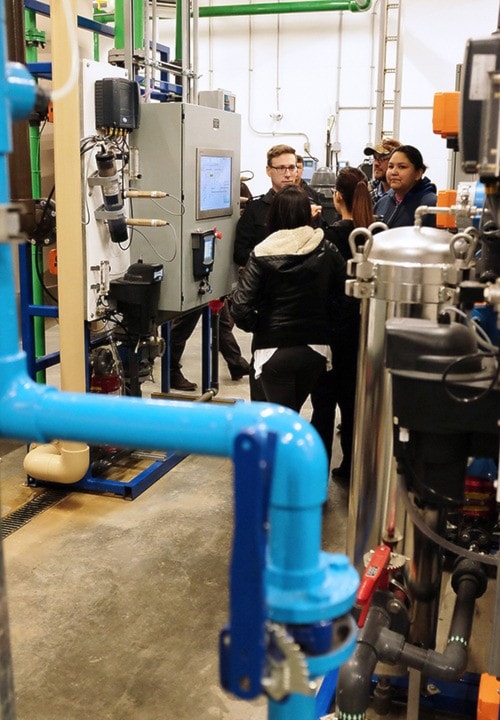If water is life then the Montana Band has much to celebrate since the opening of its new water treatment plant.
A grand opening ceremony and celebration was held Jan. 19 with those involved in the project taking part.
One of the key components to this project was the design and implementation of biological filtration as opposed to chemical disinfectants, explained Lawrence Lukey, senior project engineer with Bullee Consulting (BCL).
“This plant is a great improvement over their last plant,” said Lukey.
The biological aspect cleans out iron, manganese and ammonia out of the water to make it drinkable and to prolong the use of the membranes in the filtration system.
Lukey said the community was eager to have an updated system but also to have something more than just than the standard water treatment. Along with the biological filtration is a water distribution spot where residents can come collect clean water using large water bottles, plus the plant is fully automated.
“The water that’s going out to the distribution system is virtually bottle water quality,” said Lukey.
While the water treatment system provides cleaner water with a larger capacity, the Montana Band has also installed solar panels on the buildings in the public works yard, which brings cost savings to the monthly power bill. The peak on the water treatment building is offset to allow for more solar panels.
Designing the biological filtration system was Babak Roshani, research and development engineer with Delco Water. He said much of the groundwater in the prairies contains iron, manganese and ammonia, and chemical disinfectants are needed to purify the water, but not in this case.
The only thing added to the filter is air, this allows the microorganisms to metabolize. A biological membrane to filter the water is not new technology, says Roshani, but it is newly applied to this part of the world.
The technology has been in higher use in Europe for the last 40 years, he explained, but in the prairies the groundwater is quite a bit colder, making metabolization more difficult. “We have specialized cold-adapted microorganisms,” said Roshani.
“I am so proud that we developed this green technology,” he added.
For his part, Montana Chief Darryl Strongman is proud of the work it took to get this building completed. “Compared to the old water plant this is certainly an upgrade.”
An underground reservoir can store up to 750,000 litres of water and took about five years to complete; this included engineering and feasibility studies.
“Water is so very, very important among our First Nations,” he added.
Students at the Meskanahk Ka Nipa Wit Community School now have access to this water as well as the band’s administrative building and several homes nearby. The new plant came at a good time, said Strongman, considering the one it replaced was in dire need of an upgrade or replacement. He added his thanks to Indigenous and Northern Affairs Canada (INAC) for providing the funds to make the project a reality.
Merv Clarke, INAC manager of water strategy for Alberta, is pleased to see the overall $7.9 million project — paid in full by INAC — complete. He said there are several projects that INAC is working on and added his joy at seeing this one, to benefit Montana Band members, completed.
